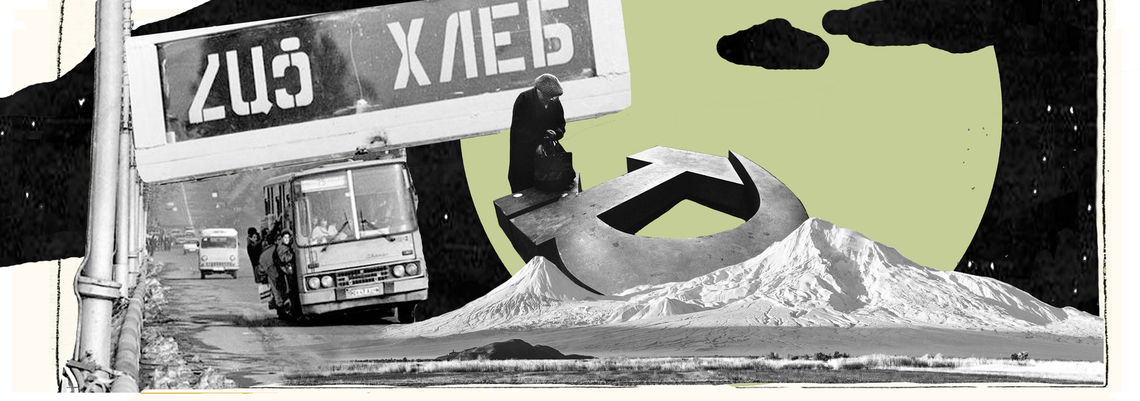
In December 1991, the four decade-long power struggle between the West and the Soviet Union came to an end. On December 25, the first and last president of the USSR, Mikhail Gorbachev resigned and the next day the newly formed Supreme Soviet of the Union of Soviet Socialist Republics proclaimed the USSR formally dissolved.
Over the course of 1991, the central government of the Soviet Union attempted to save the sinking empire. The pan-Union referendum that was called already in March was the first attempt at creating a more democratic political formation that offered more sovereignty to the republics. A number of republics, including Armenia, refused to partake in the referendum. The price for Armenia’s decision to stay on the path of independence and not participate in the referendum was the infamous Operation Ring during which the Armenian population of several dozen Armenian villages in Nagorno Karabakh was forcibly uprooted by the internal forces of the USSR Ministry of Interior and the Azerbaijani OMON. Dozens were also killed and injured in a number of border towns and villages of the Republic of Armenia.
The next attempt to transform and preserve the Union were negotiations for the New Union Treaty taking place in Novo-Ogarevo near Moscow. However the document produced as a result was not signed primarily due to the failed August Coup and also because the fall of the Soviet Union was already an irrefutable fact.
By the fall of 1991, the process of the independence of the Soviet republics had become unstoppable. Armenia held an independence referendum on September 21 and several weeks later, on October 16, the first presidential election. On November 14, three days after being sworn in, Armenia’s first President Levon Ter-Petrosyan was received in Washington by U.S. President George Bush.
Responding to a question by Armenian reporter Gurgen Khajakyan, the American president said that the U.S. was interested in the success of the Armenian Republic and that is what he intended to discuss with the Armenian president who, he said, was elected by the overwhelming majority of the people. President Bush also said that the U.S. is ready to collaborate with the republics. [1]
In the beginning of November 1991, Turkey had already recognized the independence of Azerbaijan. Ishak Alaton the director of the Turkish Alarko Holding was in Yerevan on November 11. He had come to the Armenian border from Trabzon and crossed the Markara bridge into Armenia. In Yerevan, in an interview to the Azg newspaper’s Hakob Asatryan and Hakob Chakryan, Alaton had said he was certain Turkey would soon also recognize Armenia’s independence. [2]
Canada and Poland recognized the independence of Ukraine in the beginning of December and Sergey Filatov, the First Deputy Chairman of the Supreme Soviet, announced that Russia's recognition of Ukraine's independence was inevitable.[3]
By November-December 1991, it was already evident that the Union republics would soon become independent and the USSR would no longer exist. It should be noted that the president of the Russian Federation, Boris Yeltsin, a representative of the democratic wing, was also in favor of the dissolution of the Soviet Union.
Parallel to discussions around the dissolution of the USSR, there were public and political discussions about the imperative to create a new entity that would unite the former republics. The creation of this new political union was conditioned by several factors, the first of which was the economic one. The republics were already independent and sovereign but through thousands of invisible economic and infrastructural links, they were still connected to Russia and to each other. Finding new markets was difficult and would require time.
The other important factor was political. Russia wished to maintain influence over the post-Soviet republics that had military and security significance. Russia’s military and economic assistance was also important to the newly independent republics with no defense systems, armed forces or sufficient specialists. As a result, on December 8, 1991, the presidents of Russia, Ukraine and Belarus, (Yeltsin, Kravchuk and Shushkevich) sign the Belovezh Accords declaring that the Soviet Union has effectively ceased to exist and establishing the Commonwealth of Independent States (CIS) in its place as a successor entity. Armenia joined a couple of days later.
* * *
At the twilight of the Soviet Union, the West was particularly concerned about the fate of the Soviet nuclear legacy. Besides Russia, Belarus, Ukraine and Kazakhstan also had nuclear weapons and intercontinental ballistic missiles. In the 1990s, however, due to diplomatic efforts, financial compensation and international pressure, the nuclear arsenal of these republics was neutralized. Part of it was transported to Russia and the remaining destroyed. Russia had assumed the responsibility to supervise and safeguard the nuclear arsenal of the USSR, which it did. It is difficult to imagine what the geopolitical picture of Eastern Europe would be like today if Ukraine and Belarus had nuclear weapons.
Following the collapse of the Soviet Union, conflicts that had broken out between different republics intensified and became full out wars. The military conflicts that were taking place in Nagorno-Karabakh, South Ossetia, Abkhazia and central Asia were not only claiming thousands of lives and creating humanitarian crises but they also posed a threat to Russia. These conflicts could change the local balance of power, as well as include new players into the conflict zones that were not desirable for Russia.
In 1991-1992, Russia itself was in a difficult economic situation, and the extent to which it could actively be involved in the settlement of conflicts was limited. Russia’s domestic political life more or less stabilized only after 1993, and the Russian Federation gradually began to regain its influence in the former Soviet republics. In September 1993, with Russian support, Abkhazian units were able to drive Georgians out of Sukhumi, and on December 3, Georgia became a CIS memeber state. In February of the following year, Russian President Yeltsin and Georgian President Shevardnadze would sign a friendship agreement, which would establish Russian military bases in three regions of Georgia: Batumi, Akhalkalaki and Vaziani.
Azerbaijan had joined the CIS a little sooner, in September of 1993. Heydar Aliev, who had just come to power, desperately needed Russia's support. Negotiations to end military operations in Nagorno-Karabakh had begun in January 1994, with the Russian Defense Ministry playing a key role. It should be noted that all previous attempts by the Organization for Security and Co-operation in Europe (OSCE) to establish a ceasefire in the Nagorno-Karabakh conflict zone had failed.
By mid-1994, Russia was able to significantly, if not completely, secure its strategic presence in the territory of the former Soviet republics, its “near abroad”. But the competition between the West and Russia does not end with this. In the following two decades, we see a stubborn struggle between these two civilizational polarities to increase their influence over the former Soviet republics and, in the case of Russia, to maintain its own presence.
* * *
The collapse of the Soviet Union coincided with another important development: the emergence of increasingly powerful states in Asia and the Near East, which in turn gradually led to the creation of a multipolar world order. If previously the race for power was between the collective West and the Soviet Union, each with their junior allies, then in the “new world,” more and more countries were showing initiative to establish sovereign power and occupy their “place under the sun”. Even though many of them did not have and still do not have the geopolitical pull of the West and Russia, they strive to increase their economic and political influence on a regional level. Turkey's ambitions in Syria, Iraq, the eastern Mediterranean, and its direct involvement in the 2020 Artsakh War are examples of such ambitions.
With the fall of the Soviet Union, the Warsaw Pact—a collective defense treaty—was also annulled. The USSR, Albania, Bulgaria, Poland, Hungary, the German Democratic Republic (GDR), Romania and Czechoslovakia had signed the treaty on May 14, 1955 in Warsaw establishing what was known as the Bloc of Socialist Republics. The treaty extended the influence of the Soviet Union and expanded its security zone almost to central Europe. With the dissolution of the treaty, the influence of the collective West was now expanding closer to Russia’s vital frontiers, towards Ukraine and Belarus. Both countries were by now independent and attempting to maneuver between two superpowers, Russia and the West. Though closer to Russia with their cultural and economic ties, there was and still is considerable Western inclined social strata in both counties.
The 2008 Russia-Georgia war and then later the Crimea and Eastern Ukraine conflict are evidence of boundaries which when passed, result in Russian military interference. And although the West is well aware of the possible consequences of an encroachment on Russia's strategic borders, it still, on occasion, attempts to intervene. NATO’s expansion to the East, Russia's strategic security area, created an extremely undesirable situation for Russia. As a research report by the RAND Corporation, a global policy think tank notes, superpowers are very sensitive to threats to their territory. [4] And the expansion of NATO or the possibility of it being present in the territory of the former Soviet republics is a threat to Russia. On the other hand, as is evident from the developments of recent years, NATO tends to challenge Russia's ambitions.
Recently, Western experts often analyze the implications of the actions of the West towards Russia. An analysis published in Foreign Policy states that, unlike the West, Russia's actions in the Middle East have a stabilizing role. The author quotes Russian President Putin as saying, “Saddam Hussein’s regime was not a liberal one … but it struggled against the fundamentalists. … Now, there is no more Saddam, and we witness on Iraq’s territory the infiltration of a great number of members of different terrorist organizations.”
Democracy is used as a means of spreading Western influence in many regions of the world. The effectiveness of this strategy is the subject of a separate study, but it is obvious that the over-activation of the collective West on Russian borders leads to Russia's retaliatory actions.
Western attempts to infiltrate into the sphere of Russian influence, at least to this point, have been an endeavor to weaken Russia and maintain constant tension. Russia is forced to invest in considerable military, diplomatic, economic means to sustain its own influence in its own strategic security zone. It can therefore be assumed that this tension will also persist in the foreseeable future, also because it is likely that Russia will be facing regime transformation in the upcoming years.
However, it is more important to understand when and in which scenario can “rocking the boat” result in larger clashes with more unpredictable consequences, this time between large geopolitical players.
-------------------------------
[1] Azg newspaper, November 16, 1991, Issue 79
[2] Azg newspaper, November 16, 1991, Issue 79
[3] Azg newspaper, December 4, 1991, Issue 84
[4] “Russia’s Military Interventions. Patterns, Drivers, and Signposts,” Rand Corporation, 2021.



